Greywater Gadgetry
Summary
Overview
Create a two-part system for filtering greywater. Teams will focus on communication and systems engineering as they build separate components to filter solid and liquid waste and then combine them into one device.
Learning Objectives
Students will:
- Consider the potential effects of drought and how greywater could be part of the solution.
- Design a system for filtering out solid waste or liquid waste.
- Consider effective communication strategies with their team.
- Collaborate on their design ideas to create a single two-part filtration system.
NGSS Alignment
- MS ESS3-3. Apply scientific principles to design a method for monitoring and minimizing a human impact on the environment.
- HS ESS3-4. Evaluate or refine a technological solution that reduces impacts of human activities on natural systems.
Additional Standards:
- MS-ETS1-1. Engineering Design
- HS-ETS1-2. Engineering Design
Materials
- Systems Engineer Site Visits Student Handout (2 per team)
- Conference Call Two-Part Filtration System Student Handout (1 per team)
- Clipboards (2 per team)
- Pencils (2 per team)
- Optional: Device to project a video
Building Materials
In Session 1: Designing Components, learners will have access to a different set of building materials, depending on whether they are creating solutions for solid or liquid waste. Some of these materials can be the same, but others will differ due to the different requirements of filtering out solids versus filtering out liquids.
- Arrange the building materials in the room so that each set (those materials needed to filter solids and those needed to filter liquids) is on the side of the room that corresponds with the related testing area (see Test Area Set-up).
- In Session 2: Refining the System, building materials can either remain in the same configuration or be placed together, but learners should have access to all of the materials.
| Solids and Liquids (per class of approximately 32 students) | |||
|---|---|---|---|
| Containers (~20) | Connectors (~30) | Long & Skinny Items (~20) | Tools (1 per group) |
|
|
|
|
| Liquids Only (per class of ~32 students) | Solids Only (per class of ~32 students) |
| Filtering (~25) | Filtering (~25) |
|
|
Note: This challenge is all about recycling! Try gathering recycled items ahead of time to use as building materials.
| Test Area Supplies (1 set per group of 4 students) | |
|---|---|
|
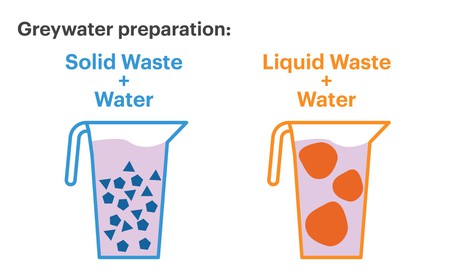 Image Credit: The Tech Interactive Image Credit: The Tech InteractiveDiagram of two different pitchers the first one is labeled 'Solid Waste + Water' and has small objects in it, the second one is labeled 'Liquid Waste + Water' and has larger blobs in it |
| Waste Material(s): You will create your own greywater mixture out of the following options: | |
|---|---|
Solid waste:
|
Liquid waste:
|
| Note: Avoid using food items that may spoil or attract insects. | |
Background Information for Teachers
What is greywater?
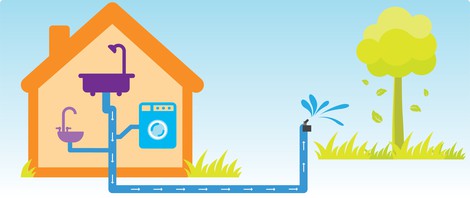
Greywater usually refers to water that is leftover while using appliances such as washing machines, bathtubs, and bathroom sinks. It does not include wastewater with harsh or harmful substances like toilet water. Greywater often contains solid and liquid waste products, such as dirt, food scraps, hair, and greases. Once these waste products have been filtered out, the remaining greywater can be used as a safe option for watering lawns and outdoor plants. Not only does recycling water help reduce water usage and save homeowners money, it also reduces the chance of greywater ending up in natural water sources and polluting them or harming wildlife.
Check out the resources below to learn more about the benefits of using greywater:
- "About Graywater," Santa Clara Valley Water website
- "Grey Water," Water Education Foundation website
- "About Greywater Reuse," Greywater Action for a Sustainable Water Culture website
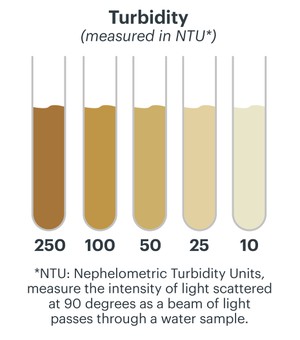
Measuring Turbidity
To determine if their liquid filtration systems are successful, learners will compare the cloudiness of their water to a Turbidity Chart. Turbidity measures the clarity of a liquid by looking at the amount of light that is scattered by substances in the water. The more opaque the water is, the higher the turbidity will be. Turbidity is also a key way to determine the quality of drinking water, with a high turbidity indicating a higher risk of getting sick. Since they are using greywater, which is not used for drinking, the learner's goal is to filter the water so it has a turbidity of 25.
Note: The Turbidity Chart will be used first by teams developing a filtration device for liquid waste, while teams filtering solid waste will rely on visual inspection to determine if solid waste has been removed. In Session 2: Refining the System, all team members will use the Turbidity Chart to measure device filtration.
Systems Engineering
In this lesson, students examine the challenges of water filtration and greywater systems through the lens of systems engineering. Systems Engineers oversee and implement the manufacturing of products to make sure all the components will work together. When a product is being developed, it is common for the various components to be designed by different teams in separate locations. Communication between these design teams is essential for success. The Systems Engineer works with the design teams to ensure there is a clear line of communication between them and that all of the components of the product will work together.
During Session 1: Designing Components, any member of their team can take on the role of the Systems Engineer and do a "site visit" to where the other half of their team is working, then report back.
- "Fundamentals of Systems Engineering," National Aeronautics and Space Administration (NASA) website
- "Systems Engineer for Environmental Satellite," Climate Kids website " 0:00 / 3:12
- "What is 'Systems Engineering?'," Computer Aided Three-Dimensional Interactive Application Community video (3:12)
Vocabulary
For more tips on vocabulary and common engineering terms see The Tech Interactive's Tech Tip: The Language of Engineering.
- Alternative Water Sources: Water supplied by sustainable sources that can be used to help offset the use of fresh surface water and groundwater.
- Drought: A period of drier-than-normal conditions.
- Greywater: Water that has been used, such as leftover water generated by washing machines, bathtubs, and bathroom sinks. It does not include wastewater with harsh or harmful substances like toilet water.
- Systems Engineering: Engineering career that involves overseeing and implementing the manufacturing of products to make sure all the components will work together.
- Turbidity: The measure of relative clarity in a liquid.
Resources and References
- "From Wastewater to Drinking Water," Columbia Climate School website
- Short animation, "Reuse Your Laundry Water with a Graywater System," (40 sec) created by Santa Clara County Water that demonstrates a household greywater system
- "About Graywater," Santa Clara Valley Water website
- "Grey Water," Water Education Foundation website
- "About Greywater Reuse," Greywater Action for a Sustainable Water Culture website
- "Fundamentals of Systems Engineering," National Aeronautics and Space Administration (NASA) website
- "Systems Engineer for Environmental Satellite," Climate Kids website " 0:00 / 3:12
- "What is 'Systems Engineering?'," Computer Aided Three-Dimensional Interactive Application Community video (3:12)
For more lesson plans, videos and other facilitation resources see thetech.org/resources.
Prep Work
Building and Test Area Set-up
In this activity, the materials and testing areas for filtering solid and liquid greywater will need to be set up on opposite sides of the classroom. Try the recommended classroom set-up below, or create your own based on the needs of your space.
- Arrange the tables used for building, placing an equal number on opposite sides of the room.
- Make sure there is enough space at each station for two pairs of learners to work independently. (Testing stations can be combined if space is limited.)
- Set up the solids building materials on a table near the solids building station. Repeat with the liquids materials on the other side of the room.
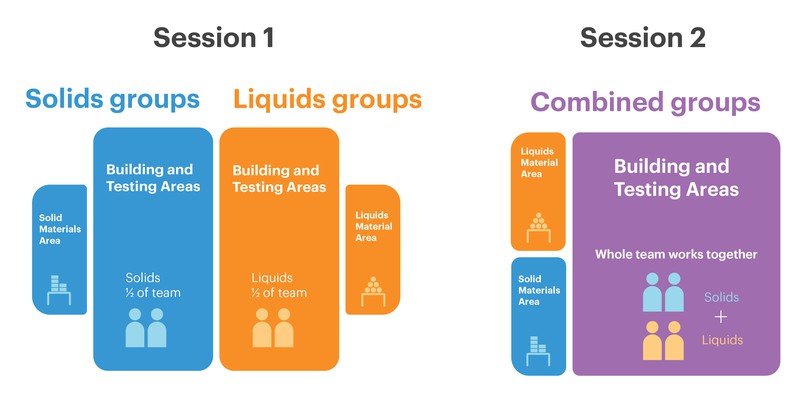
Diagram of room set ups. Session 1 shows one side labeled 'Solids group' which has a Sold Materials Area to the far left. Then a Building and Testing Area for the Solids 1/2 of the Team. The other side of the room is a mirror with Building and Testing Areas for the Liquids 1/2 of the team and Liquids materials area. In the Session 2 diagram the groups building and testing areas are combined and there is a note that the whole group works together. The materials areas are still separated but next to each other.
Lesson Preparation
- Create greywater by mixing water and waste materials in the large water containers.
- Session 1: Designing Components: Each station should have two containers of greywater that is either solids or liquids.
- Session 2: Refining the System: Each station should have two containers of greywater, each with a combination of solid and liquid greywater.
Note: Wondering how much greywater to make? Each test will take about a cup of water, so it makes sense to have four or more cups of greywater per container.
- Print Systems Engineer Site Visits and Conference Call Two-Part Filtration System handouts and Turbidity Charts.
- Optional: Consider establishing the makeup of the teams and their assigned waste material ahead of time.
- Build a solution (or solutions) yourself, with other educators or kids you know. This will give you practice with the materials and tools to be able to anticipate student questions.
Testing for this design challenge involves pouring water over the device and into a plastic tub, creating the potential for spills. To prioritize safety during prototyping, make sure that students are aware that they should...
- Always bring their device to the designated testing stations before testing.
- Never remove test materials (pitchers, tubs, etc.) from the testing stations.
- Only pour test greywater at the testing stations.
- Clean up any spills immediately
Lesson Instructions
Session Outline
| Session 1: Designing Components | 60 min |
|---|---|
| Teams are introduced to the potential uses of greywater, before designing and testing a solution for filtering either solids or liquids from water. | |
| Session 2: Refining the System | 60 min |
| Solids and liquids teams partner up and combine their devices to create a two-part filtration system. | |
Session 1: Designing Components
Lesson Outline
| Frame the Challenge | 15 min total |
|---|---|
| Activate Prior Knowledge | 5 min |
| Introduce Systems Engineering Design Challenge | 10 min |
| Design Challenge | 45 min total |
| Prototype Components | 30 min |
| Conference Call to Share Solutions | 10 min |
| Debrief | 5 min |
Frame the Challenge
Activate Prior Knowledge (5 min)
- Begin by asking learners to consider all the ways people use water in their daily lives.
- Have learners guess what percentage of clean water that comes to their home is actually used for drinking or cooking.
- On average, Americans only consume 10% of the water they use. In fact, we use 24 gallons of drinking water a day just to flush our toilets! (See "From Wastewater to Drinking Water," Columbia Climate School website, for more.)
- Ask Guiding Questions to explore what learners already know about droughts and alternative water sources:
- What are some environmental issues related to our use of water, i.e., droughts, water pollution, etc.?
- What causes these problems?
- What impact can they have on people's daily lives?
- What are some examples of alternative water sources? Where could we safely use them?
- Are there any types of water that we might be able to recycle?
- Introduce learners to greywater as water that already has been used, such as leftover water generated from washing machines, bathtubs, and bathroom sinks, but not from sources with harsh or harmful substances like toilet water.
- If learners need more context, refer to some of the Background Information.
- Optional: Project the short animation, "Reuse Your Laundry Water with a Graywater System," (40 sec) created by Santa Clara County Water that demonstrates a household greywater system.
- Let learners know that some of the waste items in greywater are safe for plants, but not all of them.
- What kind of waste items would we need to remove?
- What might help us to filter out the harmful substances?
Looking for resources on water conservation and safety for learners in grades 3-5? Check out thetech.org/down-the-drain. Here you'll find:
- A downloadable infographic on what is safe (and not safe) to send down our drains, presented in partnership with Santa Clara Valley Water District.
- Activity guide for Build a Storm Drain, a design challenge where you build a storm drain cover to protect our waterways.
- Link to The Tech Interactive's Science Labs page, where you can learn more about signing your class up for the Down the Drain Lab.
Introduce the Design Challenge (10 min)
- Introduce the design scenario:
The local water company has raised prices to pay for upgrades to their system. In order to keep their water bill down (and help the environment!), homeowners are looking for ways to recycle their greywater. Your engineering team has been tasked with figuring out the best methods for filtering solid waste and liquid waste out of the greywater, but half of the team is working on the other side of the country. Separately, you'll have to figure out how to solve the problem and share your learning with each other, and then bring together multiple components into a single design.
- Introduce the design problem, criteria, and constraints.
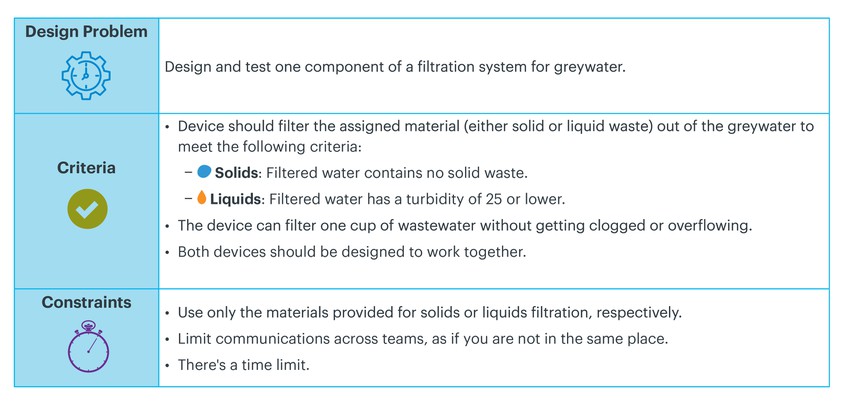
- Let learners know that there will be two types of prototyping happening simultaneously during this session.
- Half of their team will need to design a solution to filter solid waste out of greywater, while the other half will design a solution for filtering out liquid waste.
- In Session 2: Refining the System, their whole team will come together to combine their solutions into a single, two-part filtration system. Today, they will be working on separate sides of the country (i.e., the room) and have limited discussion about their processes.
- Turn learners' attention to the testing stations on both sides of the room.
- Point out the side of the room for testing solid waste, and the side for testing liquid waste.
- Make sure they are aware that each side has different building materials that are related to the type of waste they are filtering. In this session, they may only use materials from their side of the room.
- Demonstrate how to test their device. Make sure they are aware that they should:
- Point out the side of the room for testing solid waste, and the side for testing liquid waste.
Step 1
|
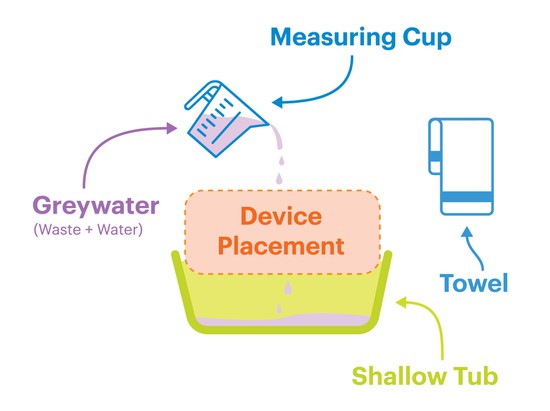
|
Step 2
|
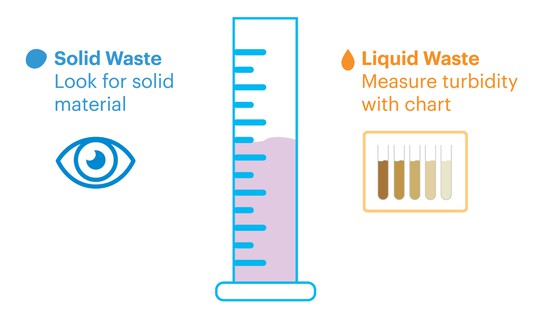
|
- Introduce the Systems Engineer role.
- Define a Systems Engineer as a person who oversees the whole production of a product.
- Systems Engineers can do "site visits" to the other side of the room and talk to the rest of their team.
- Let them know that anyone on their team can take on the role of the Systems Engineer throughout the session.
- Define a Systems Engineer as a person who oversees the whole production of a product.
- Show students the Systems Engineer Site Visits handout.
- Ask learners to record any notes, sketches, or other relevant information they learned on the worksheet.
- Note that no materials can travel between teams at this time.
- Let learners know that at the end of the build time, the whole team will have a chance to discuss their design ideas and collaborate on how they might build a combined device in the next session.
Design Challenge
Prototype Components (30 min)
- Divide learners into teams of four and pass out System Engineer Site Visits handouts, clipboards, and pencils (two sets per team).
- Have them begin by dividing up into pairs and determining which pair will develop a solution for solid waste and which will work on filtering liquid waste.
- Each pair will then go to their designated building areas.
- Once they have separated, both pairs can collect building materials from the nearby tables.
- Remind learners that they may only gather materials from their own materials table, i.e. those for filtering solids or liquids.
- Encourage teams to spend a few minutes exploring the materials before they begin building.
- During the prototyping time, walk around and support teams by asking open-ended Prototype Questions:
Just Getting Started - What features does your device need to filter greywater?
- Solids group: What materials would be best for filtering out small particles like dirt?
- Liquids group: What materials would be best for filtering out liquid waste like oils and grease?
Still Iterating - How might you adjust your design to make the greywater even less turbid?
- Think ahead if there is time. What modifications could you make so both the solid waste and liquid waste devices work together as one device?
Communicating Ideas - What information do you think the other half of the team will need to know in order to design a system that can be joined with your design in Session 2?
- How can information be gathered and shared when you are acting as the Systems Engineer?
- Teams should be testing often as they build.
- Encourage teams to send a Systems Engineer to check in with the other half of the team throughout the prototyping time.
- When the allotted time is up, have solids teams find their liquids team partners. The entire team (solids and liquids) will work together for the rest of the lesson.
- If learners appear to be relying on "word-of-mouth" to communicate other pair's ideas back to their partner, remind them that taking notes on the handout will help them when planning the combined device.
- As they work, encourage them to think of questions that they might want to ask the other team in a site visit.
- Systems engineers may want to observe the other half of their team (solid or liquid) when they are testing.
Conference Call to Share Solutions (10 min)
- Pass out one Conference Call Two-Part Filtration System handout to each team. Let them know that they will now have time to brainstorm how to combine their devices into a single two-part filtration system.
- Encourage teams to record details of their original designs for later reference, such as what building materials they used and sketches and labels of their design.
- They can bring their prototype devices to their brainstorm if they wish, but let them know that they will need to disassemble their device after they brainstorm.
- After one pair in the team shares, ask the other half of the team to offer positive feedback by saying one thing they liked or noticed.
- Support team collaboration by asking questions about their devices.
- Which parts worked well? Which of those should be included in the two-part system?
- What materials filtered waste well (solid or liquid)? What could you try instead when building your two-part system?
- Once they have finished brainstorming, collect their Conference Call Two-Part Filtration System handout and ask them to disassemble their devices if they haven't already.
Debrief (5 min)
- Lead a short debrief with the whole class. Possible Debrief Questions include:
- How challenging was it to filter the waste materials out of water?
- What similarities did you notice in your designs? Across teams or even in the solutions for different types of waste?
- What challenges might you face as you combine your designs in the next lesson?
Session 2: Refining the System
Lesson Outline
| Lesson Outline | |
|---|---|
| Frame the Challenge | 10 min total |
| Communications Best Practices | 5 min |
| Introduce New Systems Design Challenge | 5 min |
| Design Challenge | 50 min total |
| Prototyping Final Product | 35 min |
| Sharing Final Product | 10 min |
| Debrief | 5 min |
Frame the Challenge
Communication Best Practices (5 min)
- Begin by asking learners how it felt in the last session to design as part of a divided team.
- Have them think of other jobs that might require people to work in this way (e.g., international teams, teams doing space travel, teams at sea, etc.).
- Let them know that it is very common in engineering for different components of a product to be designed and constructed by different teams in separate locations. This means that communication between these design teams is essential for success.
- Ask learners about what they learned so far about collaborating while they prototyped different design solutions.
- What was it like to communicate with your teammates across the room?
- What do you think will be challenging about combining your design ideas into a two-part filtration system?
- What would you want to remember the next time you need to work with someone(s) who is in a different location from you?
Introduce New Systems Design Challenge (5 min)
- Introduce the design scenario:
The entire engineering team has traveled to the final manufacturing location to complete the production process together. The team needs to find a way to combine their design ideas into one two-part filtration system for testing.
- Introduce the design problem, criteria, and constraints.
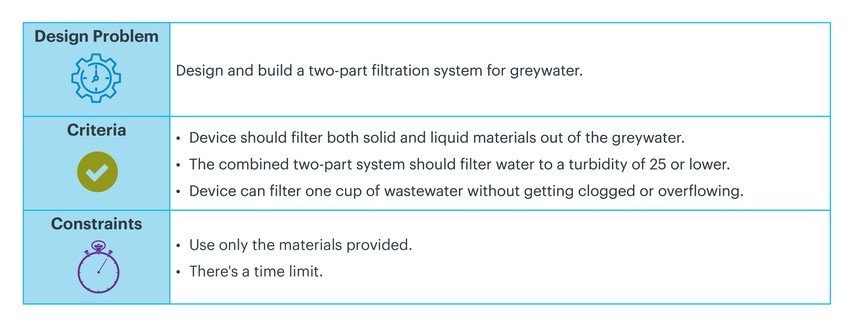
- Let learners know that, since their whole team is together now, they will not have the same restrictions on communication that they did in the previous session.
- The entire team will all work together on developing their device.
- Everyone has access to all of the building supplies.
- Turn learners' attention to the testing stations. In this session...
- All teams will be testing with greywater that has a combination of solid and liquid waste.
- Teams can test their device at any of the stations.
Design Challenge
Prototyping Final Product (35 min)
- Pass back their Conference Call Two-Part Filtration System handouts. Ask teams to spend a few minutes reviewing their plan from the previous session and decide as a team if they want to make any adjustments to the plan.
- Once the whole team has agreed on their plan, they can collect their building materials.
- During the prototyping time, walk around and support teams by asking open-ended Prototype Questions:
- What components from the last session's solid waste filtration device are being included? From the liquid waste device?
- What modifications did you have to make from your original designs to build a two-part solution?
- How are you making these different components work together as one solution?
- Is the turbidity of the greywater higher or lower than the water filtered by the devices yesterday? If it has changed, why do you think that is?
- Encourage teams to test often.
- Let teams know when there are 10 and 5 minutes left.
Sharing Final Product (10 min)
- At the end of the time limit, have teams stop even if they haven't been able to complete their design.
- Ask each team to share their design process and demonstrate their two-part filtration system. Possible Sharing Questions include:
- Tell us how your two-part filtration system works.
- What did you adjust/change on your original devices in order to combine them?
- What would you change if you had more time?
- Have learners give each other positive feedback on their designs. Encourage them to tell the other team one thing they liked or noticed.
- Remind students to focus on the process and what they learned from the experience overall. Encourage them to reflect on key mindsets like perseverance and collaboration.
Debrief (5 min)
- Lead a short debrief. Debrief topics can include the innovation design process, communicating and collaborating, and the use of greywater in the real world.
- Possible Debrief Questions include:
- Can you think of other products or inventions that are made up of components which were designed in separate locations and then assembled? (ex: wind turbines, spacecraft)
- What was easier about working as a full group? More challenging?
- What kind of impact could using greywater have on our environment?
- How could we encourage our community to install greywater filtration systems in buildings and homes?
- Fast Filtration: Challenge learners to create a speedy system for filtering greywater. See if they can tweak their devices so it filters the whole container of water in under five seconds.
- Limited Cash Flow: Give learners a budget so they can only acquire a certain amount of building materials.
Come see our Solve for Earth Exhibition at The Tech Interactive and learn more about sustainable approaches to climate change. See water systems in action on our Connections Wall and test your knowledge of water in The H2O show.





